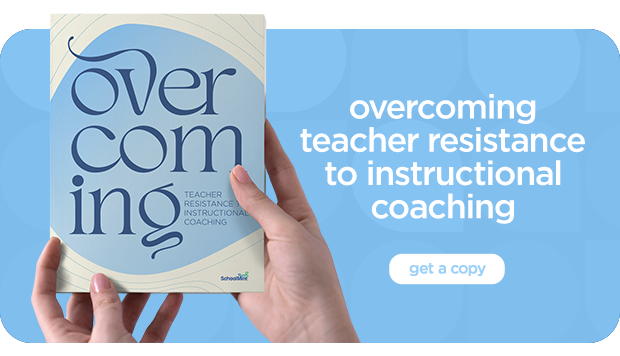It Starts with a Sticky Note: Building a Coaching Culture in Your School
Learn how you can start creating a teacher coaching culture in your school — all with the tiny-but-mighty yellow sticky note!
Instructional coaching for teachers has grown tremendously in recent years — and for good reason!
Once-a-year, compliance-based evaluations have a limited impact on classroom outcomes. Today, it’s becoming much more common instead to observe frequent, informal coaching focusing on teacher improvement and skill development to foster learning in the classroom.
So how do you build such a coaching culture within schools? SchoolMint believes in an approach that uses a quick, easy solution that gives teachers feedback that’s focused and routine.
How does it work? Let’s dive in!
What Does it Mean to Have a Coaching Culture?
Before we can dig into how to build a coaching culture in our schools and classrooms, we need first to define what exactly a coaching culture is.
Teacher coaching is not evaluation.
Though coaching may reference a rubric or common framework of teaching excellence, a teacher is typically not “rated” or scored on that rubric. Instead, instructional coaching focuses on adult professional growth and improvement.
A coaching culture, then, is the shared expectation between teachers and instructional coaches that instructional coaching will happen on a regular basis and be used for the purposes of improving teacher practice.
In Developing a Growth Mindset in Teachers and Staff by Keith Haggerty, Haggerty outlines a framework for how you can change the culture within an organization by examining different thought processes.
Haggerty references Stanford University psychologist Carol Dweck, who breaks people into two groups: those with a fixed mindset and those with a growth mindset.
- A fixed mindset refers to individuals who believe their knowledge and skill set are fixed — meaning they believe they are “stuck” (for better or worse) with the abilities they’ve had since they were young.
- By contrast, those with a growth mindset believe they have room to expand their knowledge beyond their innate abilities through practice and study.
These two schools of thought have implications for teachers as well as students.
The key for any school administrator looking to build a strong coaching culture in their school is to foster a growth mindset so their teachers are confident in their ability to improve.
As Haggerty states in the article:
Teacher performance management processes can often be quite awkward and distressing experiences; however, by viewing the process as part of a growth mindset - that is, making it formative, rather than summative, and inviting participation of the teacher in the process, the feedback can be more meaningful and applicable to the teacher’s daily practice.
It’s clear: building a growth mindset within your school empowers teachers to develop as professionals and improve upon their craft.
The next question, naturally, is how do you develop this culture within our schools? Luckily, it’s not nearly as hard or as time-consuming as you might think!
How Do I Develop a Coaching Culture in My School or District? It’s Easier Than You Think!
1. Start with Positive Feedback
Every school leader’s calendar is jam-packed with equally important priorities.
If you’re just getting started with coaching, it may seem like an impossible feat to fit it into your already busy day. The good thing is, you don’t need special training, a fancy system, or lots of money to get started using this method.
Just follow these four steps:
- Step 1: Grab a pen and a pack of traditional yellow sticky notes.
- Step 2: Enter as many classrooms as you can in under 10 minutes.
- Step 3: Write down one good thing you see happening in each classroom.
- Step 4: Leave the sticky note for the instructor.
And that’s it — you did it!
You’ve started building a culture of coaching in your school and started building the muscle of coaching within yourself.
The key here is a laser-like focus on what’s going right in the classroom. If you’re launching from a starting point without a strong coaching culture, the most important way to get going is with simple, positive feedback for your teachers.
The best way to do this is by structuring your feedback around the student, using evidence to highlight how the teacher’s strengths positively affect learning and student achievement.
This simple solution gives teachers valuable, uplifting feedback that is immediately internalized and serves to support and encourage the continued growth and development of your educators in a very holistic and impactful way.
More importantly, it gets your teachers used to receiving feedback and helps them not be anxious about a coach or administrator in their classrooms.
2. Build Into Glows and Grows
After you’ve started your routine of quick feedback with your teachers, take it a step further by separating your feedback into “Glows” and “Grows.”
Provide the teacher with a specific glow (what they’ve done well) and grow (an area where they can improve).
This two-step approach allows you to both praise a teacher’s performance and offer them suggestions for improvement at the same time.
3. Level Up to Action Steps
Simply understanding what teachers have done well and what they can improve upon is just the beginning. This knowledge is not valuable until you turn it into manageable action steps for your teachers to perform.
Use your sticky note approach to deliver a concrete action that helps guide your teachers forward.
Send a follow-up email to each teacher. This email should highlight the strengths noted during the observation, highlight any questions to consider, and offer one small action step that the teacher can implement before your next pop-in.
4. Track Your Observations and Results
Coaching is all well and good, but how will you know if it’s effective if you don’t track it? Legendary management consultant Peter Drucker once said, “What gets measured gets improved.”
To improve the performance of your teachers, students, and school overall, it’s vital to measure the success of your coaching action steps.
Consistent practice leads schools to new insights around how teachers are internalizing your coaching and whether they are growing their efficacy.
You can start tracking your observations in an Excel spreadsheet, but as you grow your methods, a more extensive software tool might be best.
Make a Plan — and Stick to It
Coaching can’t be a one-time activity.
Create a calendar of days each month so that you can set aside time for coaching and feedback.
Break down your tracked observations with each teacher and let them know ahead of time when you will make time to debrief the notes and next steps.
Why This Approach Works with Teachers
Why does this approach work so well? It’s simple: most teachers say that their yearly reviews and infrequent observations are frustratingly limiting — and can even be overwhelming. (If you previously taught in the classroom, you very likely felt this way, too!)
Infrequent, compliance-driven evaluations do not provide the teacher with consistent, concrete, and valuable feedback that allows them to truly grow and develop in their profession all year long.
But the quick-hits, sticky-note approach does.
Using sticky notes for coaching gives your educators routine feedback that is actionable and leaves them with continual, updated feedback throughout the year.
With its quick and consistent format, coaching doesn’t take up teachers’ valuable time. It also gives them a series of regular “status updates” that empower them to grow and develop on a routine basis for lasting change in the classroom.
Back to You
Encouraging a culture of coaching within your school doesn’t have to be costly or complicated.
Get started today by doing a 10-minute sprint through your classrooms with a simple sticky note, and foster a new educational environment of positivity and encouragement that’ll take your teachers to new levels of accountability, improvement, and achievement this school year.
Share this
You May Also Like
These Related Stories

6 Tactics to Getting Teachers Better Faster

Using Teacher Performance Data to Improve Instructional Performance



